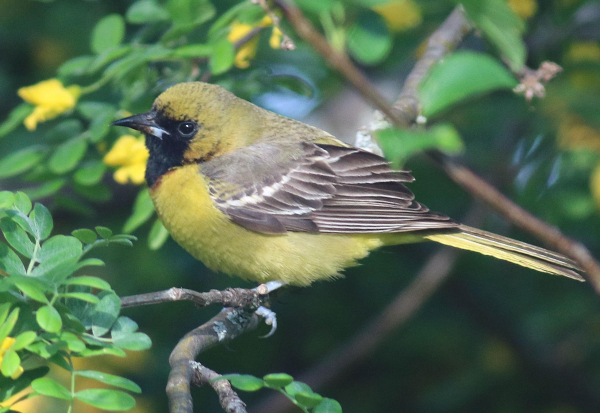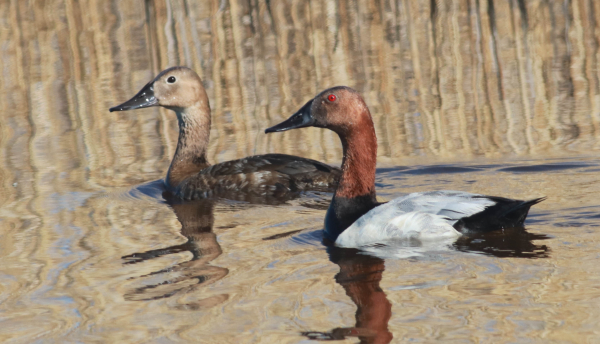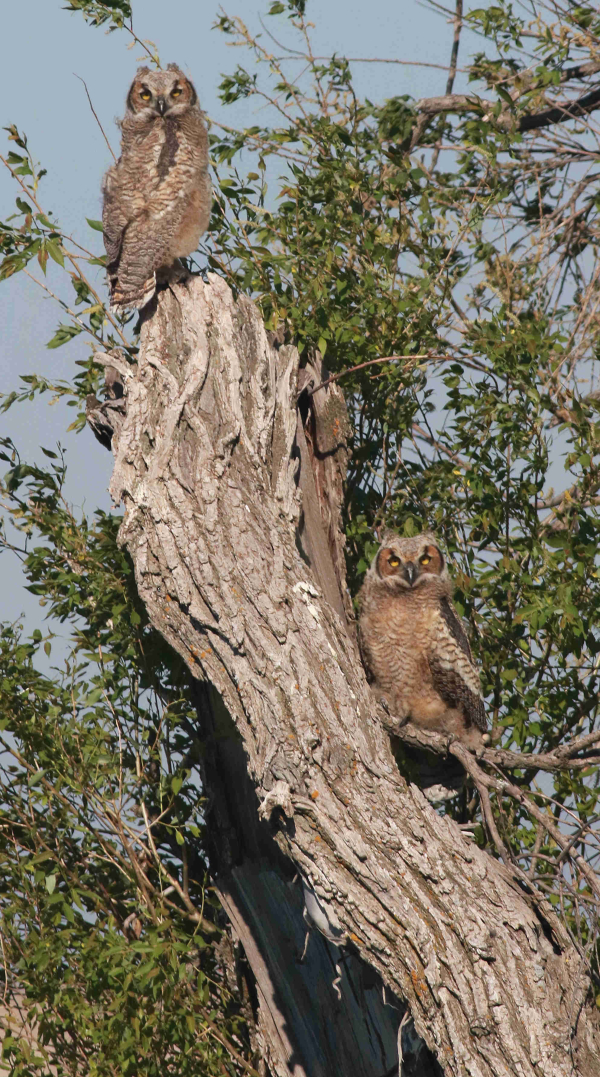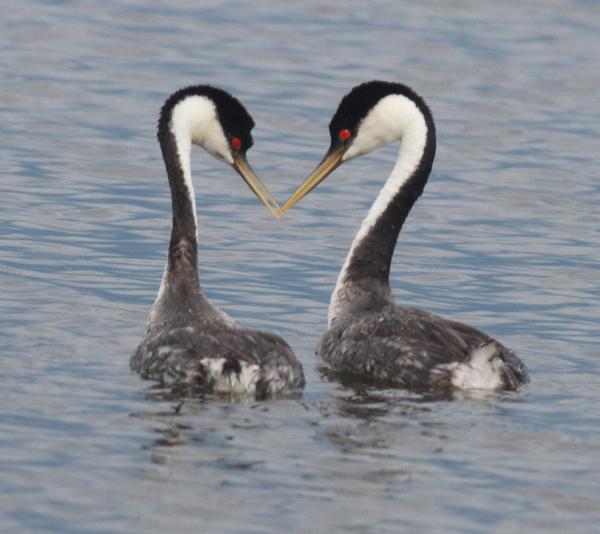
The presence of yearling male Orchard Orioles at Paul’s feeding station is a first, and it’s exciting to have this age group and color form represented in his yard.

Great Horned Owl nest mates tend to stay together for a while during the post-fledging period when they learn to fly and hunt, while being protected and fed by the adult pair.

A photo fitting of a Duck Stamp painting features a regal pair of Canvasbacks.

Western Grebes have been actively displaying during the past two weeks, including this pair.
|
By the first of June, spring migration appeared to be almost complete, and I turned my attention back to the broader surrounding landscape, noting that the female Ferruginous Hawk appeared to be feeding what I imagined were small downy nestlings in her hilltop ground nest. Same for a couple Red-tailed Hawk nests I checked, although Swainson’s Hawks are still incubating. The large nestling Great Horned Owls began “branching;” leaving the nest, perching on surrounding branches or on a bend in the tree trunk.
Just days ago, Saturday, I found the two owl nestlings from the former Ferruginous nest had fledged – the nest was empty. I found one perched 120 feet north of the nest in willows where the adults often perched; no surprise there. The following day both fledglings were perched on a willow snag, looking very young yet, despite their large size; they still showed a lot of downy feathers, especially on their heads. Another Great Horned Owl nest, located less than two miles south of my home and office, has two large nestlings that will soon leave the nest too. Coincidentally, these two pairs of adult Great Horned Owls took over hawk nests that I monitored and shared updates about with you last summer – one a Red-tailed Hawk nest, the other the Ferrug pair’s nest.
As described in detail in this issue’s Birding Lifestyles feature, I am now monitoring a new Bald Eagle nest with a trio of large nestlings about 15 miles southeast of here. I will share updates about the eagles as the season progresses, but I’ll refer you to the Lifestyles article for the introduction to this much anticipated eagle nest.
Most “dabbling ducks” are nesting now, although Canvasbacks, Redheads, Lesser Scaup, and Ruddy Ducks have yet to get serious about nesting, as usual at this point in the season. I enjoyed photographing two widely spaced pairs of Canvasbacks one afternoon, and I always marvel at the pairs’ large size and regal beauty. I also photographed displaying Ruddy Ducks and a dispute between rival males with a female.
Pairs of Western Grebes have been displaying for a couple weeks, but I’m still waiting for an opportunity to see, and possibly photograph, the grebes performing their “water dance” display. I found an incubating Pied-billed Grebe on its nest; usually these little grebes hide their nests better among emergent aquatic vegetation, but this one was obvious in an opening in the wetland. Some American Coots are still displaying, but I sighted the first colorful hatchling coot being fed by an adult Sunday. Pairs of Marbled Godwits are in pairing mode; a couple pairs were notably active with each female leading the aggressive male scrambling across a prairie area, taking flight periodically to fly in tandem.
Three White-faced Ibis caught my attention when I saw they were in full breeding plumage; usually the ibis that venture into this area are young birds that haven’t attained their adult plumage, or post-nesting birds that have begun molting. I also took some time to take portrait photos of a nice light-colored Common Nighthawk along the “lost road,” my nighthawk stronghold. So the avifauna progresses in south-central North Dakota; but it’s also been an exciting week at my “oriole cafe.”
Orchard Oriole Smackdown
The oriole mix appeared to be settling in for the summer with the apparent passing of migrating stopovers. By last Tuesday there appeared to one pair of Baltimore Orioles, and one pair of Orchard Orioles, a yearling female, and a couple yearling males. I’m back to being very interested in the interactions of the orioles, and I really appreciate their lively activities and additions of feathered color outside my work station during office days.
One yearling male is particularly handsome, but he became more and more territorial around the feeding station, engaging in aerial chases to keep other Orchards away, including the adult male. After seeing the yearling chase the adult male twice (although it may have happened more often), the adult faced off with the yearling at a nearby tree. For some moments the adult moved to stand on the ground, then it flew directly at the yearling to engage in an all-out aerial fight that continued from about seven feet high all the way to the ground and ensued for minutes. The adult male obviously was in control, but the yearling was not giving in at all. Finally the two separated after much wing beating and kicking and beak sparring and biting, with the adult pinning the yearling down a few times before they finally separated.
The yearling was noticeably tired if not beaten, and seemed it to be hiding behind the base of the tree trunk to at least catch its breath, and perhaps its composure. But the adult returned and perched nearby on the same tree trunk, looking down at the yearling. In a few moments, the yearling boldly climbed up the trunk toward the adult male, but after another moment of showdown between the two, the adult male left the scene. Wow, that was as dramatic a bird fight as I’ve seen in a long time. It would be interesting to see how things shake out between them. As the evening progressed, both birds returned to the feeding station, separately, although the adult male was with a female, which has been the case the past couple days.
The yearling male sings often at the feeding station, or in the low branches adjacent to it, which has been nice. The yearling Orchard no longer interacts with any adult orioles – Orchard or Baltimore – but he is intensely territorial with a yearling pair of Orchard Orioles, which is interesting in itself. The second yearling male appears to be paired or is pairing with what appears to be a yearling female. The two remaining yearling males – the territorial one and the pairing yearling – are the first yearling males at the feeding station, so it’s exciting to have this age group and color form represented in my yard.
Friday I sensed a change at the oriole cafe – the adult male Orchard and Baltimore Orioles were both coming to the feeding station solo. Where were the females? Have they begun incubating? I was surprised the pairs slipped so quickly into the nesting mode. Perhaps they had been working in that direction before this week, but it was hard to tell what was going on behavior-wise while migrating orioles were still using the feeders. If the adults have begun nesting, I’m very excited to have both species nesting here again! By Saturday, only males were visiting the oriole cafe.
Sunday, I had a surprise visitor to my feeding station – a Red-breasted Nuthatch, although its breast was quite white rather than rufous. It was probably a young non-breeding bird, but I usually do not see the species after early May in this area.
Warbler Rerun
So last week marked a pretty serious transition from May to June – from spring migration to summer nesting. Having noted that, I must revisit the warbler parade a moment to revel one more time about how enjoyable it was to have such a surprising and photographable parade of warblers a couple hundred yards away from home at Melody’s Grove. That rather short-lived (week-long) event was preceded by my eye-opening visit to McGee Marsh on the southwest shore of Lake Erie. The birds were somewhat similar, but the difference between such social birding opportunities in Ohio to the tranquility of my solo photo blind was quite opposite from one another. The behavior of the warblers was also different; at Melody’s Grove the warblers tended to have a surprise affect when they would literally pop out of the leaves into the open, or more open wooded edges. All in all, it was an amazing warbler season, and I am somewhat surprised at what a hold those beautiful and diverse little birds had on me, day after day. What fun!
Enjoy your week, search for some avian excitement, and learn from the birds around you.
Article and photos by Paul Konrad
Share your bird sightings and photos at editorstbw2@gmail.com